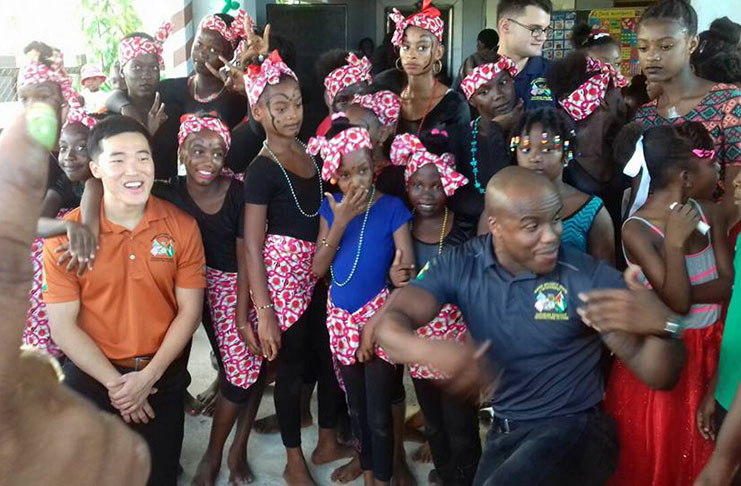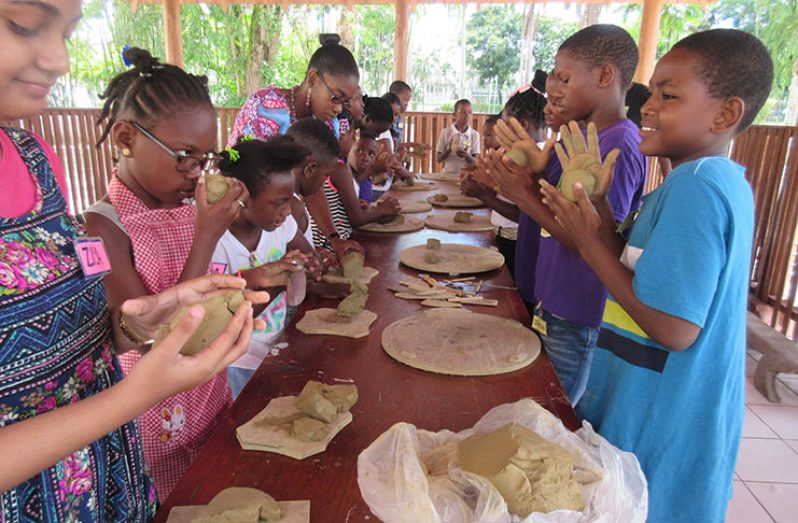Countrywide recreational programmes boosting children’s capacities
SUMMER programmes are being wrapped up countrywide as the end of the July/August holiday fast approaches, but undeniably participating children and youths are being left with new experiences, wider knowledge and greater skills that can definitely boost their resourcefulness in society.

Whether it has been a wide array of skill-building exercises, medical outreaches or enlightening anthropological sessions, various entities have held specially designed educational and recreational initiatives that have benefited hundreds of children and young people.
In Essequibo, the Ministry of Education’s Department of Culture, Youth and Sport is staging the final leg of the 2017 series of day camps, under the guidance of Region Two Youth Officer Herald Alves. So far, over 200 children between the ages of nine and 11 have participated in one-week recreational and educational camps held at Queenstown and Suddie. The last camp takes place during this week at Aurora and will cater for an additional 65 participants.

Alves explained that the initiative is held annually and focuses on the creative arts where the children are taught how to utilise and recycle materials that are being thrown away such as glass and plastic bottles, cardboard and used paper. They are also exposed to their environment from which they can identify and creatively incorporate items such as shells and beads to produce craft. The sessions are guided by a team of experienced volunteers from various communities in which the events are held.
The camps are conducted daily for six days and also include guided tours of the local rice-milling complex and other field trips. At the end of each camp, a mini exhibition and graduation ceremony are hosted for the participants.
Additionally, in partnership with the Ministry of Public Health’s Health Promotion Department, a dental outreach was held in Wakapoa, an Amerindian reservation in the Pomeroon,, where over 60 adults and children benefited from extractions, cleaning and other services. Footballs were also donated to the community’s secondary school. All of the activities form part of Essequibo’s summer programmes.

Meanwhile, a similar recreational day camp programme was held in Sophia by the Sophia Sparkle Youth Group, spearheaded by Coordinator Doris Shelto-Mclennon and involved a team of volunteers from the community and other local organisations. There were reading and public-speaking sessions, storytelling, handicraft-making, games, tours to places of interest around the city and motivational talks from prominent individuals.
Calypsonian Young Bill Rogers engaged the participants in a group discussion that focused on the importance of good morals and an unblemished character within society. He also congratulated the group on its efforts, and encouraged participants to “embrace the teachings, so as to be better persons in society,” according to Shelto-Mclennon.
A meeting was held with the community’s young teachers “aimed at reminding them of their roles towards the organization; and they also received tokens for their sterling contribution to the development of the group and its affairs,” related the coordinator.
The camp ended on Saturday with a graduation and cultural show attended by special invitees including a visiting group from the United States Army Marine Corps and Young Bill Rogers. Certificates of participation were distributed to the children and they also entertained their parents, guardians and relatives with songs, dances, poems and skits.
Children’s archaeology programme
In Georgetown, the Walter Roth Museum of Anthropology on Main Street hosted its fifth annual Archaeology Programme and included children from areas across the city, the East and West Bank Demerara and East and West Coast Demerara. It was held under the theme: “Educating students through history, inspiring creativity and adventures” and was supported by the National Trust of Guyana, Burrowes School of Art and the Volunteer Services Platform.
Students were allowed to express themselves through drawings, paintings, molding of pottery, drama, visits to historical sites and the indigenous community of St. Cuthbert’s Mission. The children were hosted in two sessions, level one from July 17 to 24 catered for ages eight to 11, while level two, from July 31 to August 11, targeted children ages 12 to 15.
Level one teacher Dinesha Barton explained that the children were taught about the Amerindians, their ways of life and forms of communication used in ancient times. She said there were in-class sessions, creativity exercises and a field trip to St Cuthbert’s Mission, which is the designated village for Amerindian Heritage Celebrations this year. During the visit, the children distributed snacks and socialised with children from the community.
She explained that the teachings were intended to support the primary schools’ curriculum and the participants were excited and learnt a lot. They were exposed to pottery, handicraft using shells, feathers and tibisiri and model-making of arrows and bows using straws and strings. At the end of the programme, each child was required to write an essay about their experience and knowledge gained during the session.
The secondary programme focused on anthropology and its sub-disciplines, such as cultural anthropology, linguistics and archaeology. Efforts were made to incorporate the current secondary schools’ History and Social Studies Syllabus to better equip students with greater knowledge for the Caribbean Secondary Education Council Examination or any other examination in the school system.
Nankumarie Singh, who taught level two, said the children were intrigued by the wealth of information gathered during the programme and many expressed a desire to return for such initiatives. They were exposed to the ceramic analysis of pottery made by the Amerindians and received first-hand exposure to excavation.
They were trained on tie-dye too and also engaged in a session on ethnobotany, focusing on medicinal plants used by the indigenous peoples. This class was conducted by the museum’s anthropologic researcher Mintie Pitamber, who guided the students in an experiment on the use of various plants to treat the common cold and others.
At St Cuthbert’s, the students met the community’s cultural group, visited a farm, interacted with villagers and presented stationery to the community’s school.
The Museum of African Heritage staged a similar programme during August 7 to 11 with participants ages five to 15 and under the theme: “Developing self-impression using African themes.” Activities included focus on the museum and its collection, storytelling, painting and drawing, craft-making and field visits.
The E.R. Burrowes School of Art held a two-week day camp, four-week children art programme, a five-week modular art programme and an introductory fashion design programme as well as an advanced class.
The School of Dance taught drumming and dance at locations countrywide, including Georgetown, Zeeburg, West Coast Demerara, Goed Intent, West Bank Demerara, Linden and at Mainstay and Capoey in Essequibo.




.png)









